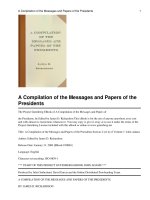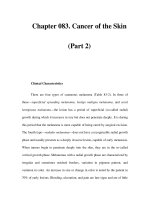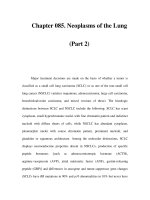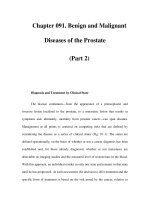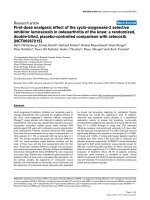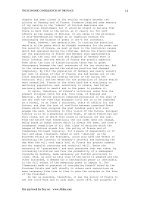Rocks materials of the solid earthchapter 2
Bạn đang xem bản rút gọn của tài liệu. Xem và tải ngay bản đầy đủ của tài liệu tại đây (7.32 MB, 92 trang )
Rocks: Materials of
the Solid Earth
Chapter 2
Earth Science, 6e
Modified by Dr. Kane
What is a Rock?
How would you define a rock and a
mineral?
What types of Rocks are there?
Igneous Rocks: from magma or lava
Origin: igneous activity
• Example: granite or basalt
Sedimentary rocks: from sediments
Origin: weathering and erosion
Example: sandstone or clay
Metamorphic rocks: from stress
Origin: mountain building
Example: gneiss or marble
The rock cycle (page 45)
PART – I: IGNEOUS ROCKS
FEEDBACK:
From what process igneous rocks from?
Plate Margins
• Divergent: Plates pull apart
Example: Mid ocean ridge; Rift
• Convergent: Plate come together
– Ocean – Continent; Ex: Cascades, Andes
– Ocean – Ocean; Ex: Japan, Caribbean
– Continent – Continent; Himalaya
• Transform Fault: Plates slide
Origin of Magma (page 228)
Magma forms at three major geological
settings:
• Divergent (Ex: Mid ocean ridge)
• Convergent (Ex: Cascades volcanoes)
• Intra plate Not a plate margin (Ex: Hawaii,
Hot spot)
Origin of Magma (page 148)
Mid Ocean Ridge (divergent)
Subduction Zone (Convergent)
Causes of Magma Formation
Decompression Melting (opening a bottle of
soda)
Factors influencing magma formation:
1. Heat Increase
2. Reduction of confining Pressure
Role of volatiles (gases)
Types of Igneous rocks
Magma cools and crystallizes
Inside the crust → Plutonic or Intrusive rocks
Lava cools and crystallizes
Outside the crust → volcanic or extrusive rocks
Classification of Igneous rocks
When identifying Igneous rocks look
for:
1. Grain Size (TEXTURE)
and
1. Rock color (CHEMICAL COMPOSITION)
Rate of Cooling and Crystal Size
• Texture is size and arrangement of crystals
• Crystal size is determined by the rate and
depth of cooling of magma/lava
• Slow rate forms large crystals
• Fast rate forms microscopic crystals
• Very fast rate forms glass
Feedback:
The slower the rate
of cooling, the
smaller / larger the
crystals?
Types of Textures
Phaneritic: Coarse grain/slow cooling rate
Example: Granite or Diorite
Aphanitic: Fine grain/fast cooling rate
Example: basalt or rhyolite
Glassy: glasslike/very fast cooling rate
Example: Obsidian (volcanic rock)
Types of Textures
Porphyritic: Slow then rapid cooling
Example: porphyry basalt, porphyry granite
Vesicular: Full of holes due to gases
Example: Vesicular basalt, scoria, and pumice
Pyroclastic: Angular volcanic fragments
cemented by ash from violent eruptions
Example: tuff
Photomicrograph
Photomicrograph
What’s the texture?
What’s the texture?
What’s the texture?
What’s the texture?
What’s the texture?
Obsidian Aztec

